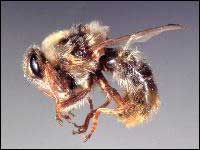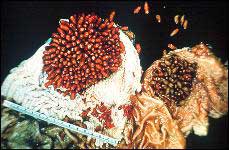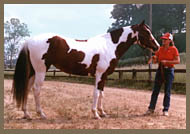Bot Flies and Bot Fly Egg Removal
Equine Parasite Management and Ivermectin to the Rescue!
© 2007, Karen Griffith. All rights reserved.
To reprint this article call (740) 992-5782 or e-mail griffith@frognet.net
"The bots
were terrible this summer!"
Sound familiar, as everyone scratches their head wondering what
to do about the aggravating situation?
|
Be the very best horse person you
can be!
Karen always helps educate her customers
on Equine medicine and care. Click on the Home
Link in the toolbar to the left to see what is currently
going on at Karen Griffith Farms and begin navigating her
site in it's entirety.
You'll love what you see!
Karen continually educates people who breed to her stallions
or buy horses from her on any equine topic they choose.
Do business with Karen. She cares about your equine education.
|
As open agricultural
space decreases, your own worming and management regime comes
into attack. As equine owning neighbors are encroaching closer
to your property, keep in mind that your own worming program may
become inadequate. Bot flies are a threat that needs to be addressed.
Even if you have used a rotational worming program that includes
Ivermectin, your neighbors may not. With the advantage of flight,
the adult bot fly can migrate to your farm with ease.
Many people do not know that one female adult bot fly can lay
from 300 to 1000 eggs in her short life span. (If you see
something that looks like a honey bee hovering around your horses
legs or chin, feel free to snatch this critter out of the air,
crush it and throw it into your trash can. Don't throw the crushed
bot fly on the ground where your horse may pick it up in any feeding,
i.e. pasture, hay, or grain. If the horse eats the bot fly, he
could ingest the mature, unlaid eggs of the dead bot fly.)
 The
adult bot fly has no other goal in life than to lay eggs.
It may look like a honey bee, but it has no moving mouth parts
to bite or eat and no stinger to sting. It's soul life function
is to lay it's eggs on the hair of your horse in order to reproduce
itself. The
adult bot fly has no other goal in life than to lay eggs.
It may look like a honey bee, but it has no moving mouth parts
to bite or eat and no stinger to sting. It's soul life function
is to lay it's eggs on the hair of your horse in order to reproduce
itself.
Those little tan specks you see attached to the hairs on your
horses legs, flanks, shoulders, mane, and chin are the eggs of
the bot fly and need to be removed. Some folks recommend sponging
the areas where the bot fly eggs are attached with warm water
(115°-120° F) to stimulate some eggs to hatch, then wash
away the small larvae. I've never found this to be effective.
Some say that Vaseline applied to the areas covered by the eggs
will suffocate the eggs and they will die. That sounds fine in
theory, but who wants a Vaseline covered horse with all of the
dirt and debris that would inevitably stick to the grease! (Not
a pretty picture...)
There are commercial "bot scrapers" available. They resemble a
rough, porous stone. When rubbed with the lay of the hair, the
eggs are removed.
I find the best and most simple removal method to be an old fashioned
razor used to scrape these invaders off your horse. Make sure
when you do this, you have the horse in an area where he or his
buddies will never be eating (i.e. a gravel driveway away from
your pasture). Or, stand your horse on a tarp, scrape the eggs,
and then take the tarp away to be cleaned where no livestock will
be eating in the future. (If your horse or pony has never walked
across a tarp before, you might want to head over to that driveway
that I mentioned! A "tarp walking" training session should be
in order for your horse as a general rule.)
If you don't remove these eggs, the horse will lick his legs and
flanks or scratch and lick his buddies mane or shoulder and your
horse will have taken in more invaders. Your horse's saliva provides
the enzymes, moisture, and temperature that allows the egg to
release it's tiny larvae from the hair to which it was attached
and be ingested by your horse. These larvae then spend about a
month burrowed in the mouth of the horse where they evolve. They
are then swallowed during a larval growth stage and attach to
your horses stomach lining.
Picture, again, the number of tiny specs you have seen attached
to all of the hairs on your horse. Now picture that number of
bot larvae with very sharp mouth parts, lined up side by side,
top to bottom, attached and almost covering the entire lining
of your horse's stomach.  Imagine
the lining of your horse's stomach covered with these hungry,
developing invaders at the onset of winter. How can you expect
your beautiful, shiny partner to have enough available stomach
lining to digest that perfect diet and expensive food with which
you are providing him? How can he accomplish the tasks to which
you aim? Imagine the lack of open stomach lining available to
your loyal partner. These hungry little critters (unless disrupted
by a good dewormer - antelthelmic) will stay attached to the stomach
lining of your dependable partner until spring. (They can stay
attached to the stomach for 8-10 months, causing the stomach lining
to become ulcerated and inflamed. Actual stomach ruptures from
heavy bot infestations have occurred.) Imagine
the lining of your horse's stomach covered with these hungry,
developing invaders at the onset of winter. How can you expect
your beautiful, shiny partner to have enough available stomach
lining to digest that perfect diet and expensive food with which
you are providing him? How can he accomplish the tasks to which
you aim? Imagine the lack of open stomach lining available to
your loyal partner. These hungry little critters (unless disrupted
by a good dewormer - antelthelmic) will stay attached to the stomach
lining of your dependable partner until spring. (They can stay
attached to the stomach for 8-10 months, causing the stomach lining
to become ulcerated and inflamed. Actual stomach ruptures from
heavy bot infestations have occurred.)
 The
bot larvae will then release their hold on the stomach lining,
pass through the small and large intestines, and are deposited
with the manure into your pasture. The bot is now in the pupae
form and burrows down through the manure and into the soil. They
will then mature and emerge as adult bot flies. The
bot larvae will then release their hold on the stomach lining,
pass through the small and large intestines, and are deposited
with the manure into your pasture. The bot is now in the pupae
form and burrows down through the manure and into the soil. They
will then mature and emerge as adult bot flies.
Keep in mind how many of these deposited eggs there were on the
hairs of your horse's legs, shoulders, mane, flank and chin, each
forming another adult bot fly who will each lay another 300 to
1000 eggs.
If you worm your horse with an effective wormer, (i.e. Ivermectin
products work great!) you will loosen these critters from the
stomach lining prior to their ability to mature. They will pass
through your horse harmlessly, and end this dangerous cycle.
If you are an old timer in the horse business, your will remember
how toxic the old drugs were that eliminated bots. Some were worse
on the horse than the infestation of bots themselves. We are a
lucky bunch today. With the advent of Ivermectin, bot removal
is a relatively easy task in our equine friends. Make sure if
you haven't wormed your horse for bots up to this point, that
you do so 30 days after the first killing frost in your part of
the country. No further eggs will be laid on your horse, as the
adult flies will have frozen to death. Immediately, after the
first killing frost, make sure that you remove the bot fly eggs
currently present on the hairs of your horse. This will allow
the bots that have burrowed into your horse's mouth to have time
to migrate to your horse's stomach where the Ivermectin will effectively
eliminate these parasites. (Keep in mind that Ivermectin will
kill some of these burrowed larvae in the mouth.) This will break
the reproductive cycle of this taxing parasite. Once you have
removed all of the eggs which will prevent your horse's intake
of new parasites, and have used a boticide, i.e. Ivermectin, 30
days after the first killing frost, your own personal farm's problems
have been solved for the year.
As I mentioned in the beginning of this article, the arrival of
new and uneducated horse owners to your area is almost inevitable.
Keep in mind the value of welcoming your new equine neighbors
to your horse community and discussing the benefits of neighborhood
wide control of the pests who threaten your mutual equine friends.
Educate yourself on effective mosquito and fly control as well.
You and your neighbors must work together for effective parasite
and pest control whether they be spread through air, water or
physically being brought to your farm.
P.S. For all of you scientific lingo folks, there are 3 species
of the bot fly that target your horse.*The
main difference in the species is where they choose to lay their
eggs.
Three Species of Bot Fly:
- Common
horse bot - Gastrophilus intestinalis *Legs,
sides, flanks
- Throat
bot - Gastrophilus nasalis *Under
the head, neck, mane
- Nose bot
- Gastrophilus haemorrhoidalis *Muzzle
There, that
little tidbit is out of the way.......
Bot Fly and
Bot Fly Larvae Photo credits: J. F. Butler, Department of Entomology
and Nematology, Cooperative Extension Service
Institute of Food and Agricultural Sciences, University of Florida,
Gainesville
The material
presented in this article is provided for educational and informational
purposes only. Decisions regarding the health and welfare of your
horse or pony should be made only after consultation with a licensed
veterinarian. For your horse's health, it is important that you
develop and maintain a good working relationship with your local
veterinarian.
Karen
Griffith - Equine Nutritional and Farm Management Consultant
Ohio State University - 1974
Karen has
been doing equine and livestock nutritional and farm management
consulting work all across the United States since the early 80's.
She is a 1974 graduate of The Ohio State University, College of
Agriculture, with a Bachelor of Science degree in Animal Science.
She returned to obtain a second degree in Agricultural Education,
and her Master's work is in Large Animal Nutrition and physiology.
Karen also has served as head research associate for the O.S.U.
Surgical Research Department.
Professional equine articles by Karen Griffith have appeared in
many top equine publications.
Karen served as Equine Science director for the Delaware City-County
Joint Vocational School, Delaware, Ohio. She developed the curriculum
for the program which included anatomy, nutrition, parasite control,
reproductive physiology, stable and farm management, stallion
and mare management, sales, farm promotion and advertising, western
and English riding, and the breaking and training of young horses.
She coached their horse judging team to a State Championship and
Top National Status. During this busy time, Karen also served
as coach and riding instructor for Ohio Wesleyan University in
Delaware, Ohio.
Karen was a livestock nutritionist and field manager for the Furst-McNess
Co., of Freeport, Illinois. Here she was responsible for the success
and nutritional programs of over 100 dairy, beef, hog, and horse
operations including the entire West Virginia State Farm Commission.
Karen was breeding top quality Paint horses before the Paint Horse
Association was ever founded. Her first great foundation Paint
mare was born in 1959. (The APHA was formed in 1963.) In 1973
when Atahi arrived on the scene, the bar was raised as to the
quality of horses with "color". Her horses have been
a major competitive factor in the industry. Karen's breeding program
has produced some of the most successful horses and ponies to
be found in North America to this date.
Want to see your farm turn a profit? Make your own breeding or
sales operation profitable. To find out how to speak with Karen
Griffith personally, click on the underlined text: Paint
horses, paint stallions, equine nutrition information and farm
management consulting.
Back
to the Home Page
|

 The
adult bot fly has no other goal in life than to lay eggs.
It may look like a honey bee, but it has no moving mouth parts
to bite or eat and no stinger to sting. It's soul life function
is to lay it's eggs on the hair of your horse in order to reproduce
itself.
The
adult bot fly has no other goal in life than to lay eggs.
It may look like a honey bee, but it has no moving mouth parts
to bite or eat and no stinger to sting. It's soul life function
is to lay it's eggs on the hair of your horse in order to reproduce
itself. Imagine
the lining of your horse's stomach covered with these hungry,
developing invaders at the onset of winter. How can you expect
your beautiful, shiny partner to have enough available stomach
lining to digest that perfect diet and expensive food with which
you are providing him? How can he accomplish the tasks to which
you aim? Imagine the lack of open stomach lining available to
your loyal partner. These hungry little critters (unless disrupted
by a good dewormer - antelthelmic) will stay attached to the stomach
lining of your dependable partner until spring. (They can stay
attached to the stomach for 8-10 months, causing the stomach lining
to become ulcerated and inflamed. Actual stomach ruptures from
heavy bot infestations have occurred.)
Imagine
the lining of your horse's stomach covered with these hungry,
developing invaders at the onset of winter. How can you expect
your beautiful, shiny partner to have enough available stomach
lining to digest that perfect diet and expensive food with which
you are providing him? How can he accomplish the tasks to which
you aim? Imagine the lack of open stomach lining available to
your loyal partner. These hungry little critters (unless disrupted
by a good dewormer - antelthelmic) will stay attached to the stomach
lining of your dependable partner until spring. (They can stay
attached to the stomach for 8-10 months, causing the stomach lining
to become ulcerated and inflamed. Actual stomach ruptures from
heavy bot infestations have occurred.) The
bot larvae will then release their hold on the stomach lining,
pass through the small and large intestines, and are deposited
with the manure into your pasture. The bot is now in the pupae
form and burrows down through the manure and into the soil. They
will then mature and emerge as adult bot flies.
The
bot larvae will then release their hold on the stomach lining,
pass through the small and large intestines, and are deposited
with the manure into your pasture. The bot is now in the pupae
form and burrows down through the manure and into the soil. They
will then mature and emerge as adult bot flies.